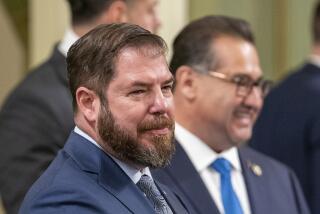B of A to Help Lower-Income Borrowers
- Share via
WASHINGTON — One of the country’s largest banks plans to lend half a billion dollars in home mortgage money--requiring no down payment cash whatsoever--to people it feels are poorly served by traditional lending rules: lower- and moderate-income borrowers with good credit but insufficient money to make even a small down payment.
On March 2, the mortgage subsidiary of Bank of America began offering the nation’s first large-scale no-down program targeted at both new home buyers and homeowners wishing to refinance.
Dubbed “Neighborhood Advantage Zero Down,” the program will not only allow qualified applicants to dispense with a down payment but will let them pay their closing costs with funds they obtain as a gift, a loan, a grant or as a concession from the home seller.
The interest rate on 30-year fixed-rated zero-down loans will be the same one that the bank charges customers on regular mortgages. The maximum loan size will be $227,150 (in Alaska and Hawaii, it will be $300,000).
Eligible applicants should have incomes generally no higher than 80% of their metropolitan area’s median income. In Los Angeles, the maximum income is $39,840.
Compared with existing alternatives for cash-short home buyers--chiefly 3% down programs from Fannie Mae and low down payment Federal Housing Administration mortgages--the new plan will cut applicants’ up-front costs of acquiring or refinancing a home by more than half.
For example, on a typical $100,000 FHA loan, according to Bank of America calculations, the total “cash to close” for the borrower comes to $5,219, including down payment, origination and settlement charges. On a 3% down, Fannie Mae 97 mortgage, the comparable costs would total $4,996.
On a zero-down mortgage, by contrast, total cash to close would come to $2,028--$600 for appraisal, credit and other fees, $808 in standard closing costs and $620 for escrow and hazard insurance reserves.
The full $2,028 could come via a gift from relatives, a loan, a local government or nonprofit agency grant or from the seller.
Once the deal is closed, zero-down applicants probably will owe slightly higher monthly payments than competing low-down-payment plans.
Continuing the $100,000 example, on an FHA loan at 8%, borrowers would pay $893 a month for principal, interest, insurance and taxes. On the zero-down Bank of America mortgage, the monthly payment would be $940 because of higher mortgage insurance costs. Given the up-front cash savings of $3,191 at closing, the Bank of America plan would be cheaper than FHA for nearly six years.
What’s behind this huge bank’s sudden half-billion-dollar mortgage splash? Isn’t it risky for a federally insured banking institution to go handing out home loans with no down payments?
Behind the scene, several significant developments are at work. For starters, new research on the credit worthiness of home loan borrowers has revealed that credit quality--as measured by credit bureau risk scores--does not neatly track income.
The fact that your income is below average for your area does not mean your credit rating is below par. Put another way: How you handle your credit obligations is not necessarily related to how much income you earn.
According to recent data analyzed by GE Capital Mortgage Insurance Corp., in a statistical sample of home loan borrowers with incomes below 80% of their market’s median, 38% of them had credit scores in the highest category. Among borrowers with high incomes--nearly double the area median--just 35% were in the very highest credit score category.
Bank of America, using mortgage insurance from GE Capital, is targeting this previously unheralded market niche of high credit-quality, lower- to moderate-income households for its zero-down program.
“We believe that there are substantial numbers of people out there for whom the main barrier [to homeownership] is not credit but the cash to close,” said Stephanie Smith, BankAmerica Mortgage Corp.’s national manager of community lending.
A second key factor: the recent development of electronic credit-scoring programs that allow lenders to better identify who’s really a good credit risk and who’s not.
GE Capital Mortgage Insurance has developed one of the industry’s most sophisticated programs, known as “Omniscore,” which purports to predict with accuracy the likelihood of default by any mortgage applicant. Many, but not all, applicants for zero-down loans will be screened by GE’s high-tech Omniscore.
Also critical to the new program: a pledge by Bank of America’s parent company, BankAmerica Corp., a $260-billion holding company, to cover any financial losses on the top 3% of each zero-down loan. In effect, the bank is filling the gap between a typical 3% down loan program and the new zero-down by pledging funds to cover the missing down payment should a default or foreclosure occur.
The new zero-down program is available in California, 22 other states and the District of Columbia.
For information, contact your local BankAmerica Mortgage office or Bank of America branch.
*
Distributed by the Washington Post Writers Group.
More to Read
Sign up for Essential California
The most important California stories and recommendations in your inbox every morning.
You may occasionally receive promotional content from the Los Angeles Times.













